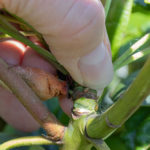Disbudding Rhododendrons

Rhododendrons are considered among the more difficult plants to trim. Many sources of information about pruning Rhododendron come from the Southern and Western states. The usual complaint about Rhododendron is that they get too large. That is not a big problem in the Midwest.
"Disbudding" refers to two aspects of pruning Rhododendrons. The first is simply removing spent blossoms. I’ve heard arguments over the years that, unless removed, the old flowerbuds will inhibit production of new flowers. I found absolutely no reference to this in my research travels. Also, to me this makes no sense. Mother nature put those flowers there and she can take them off – the shrub will bloom again! The best reason to remove them is one of aesthetics.

New growth comes from just below the flowers
The second aspect of disbudding is pruning a Rhododendron for shape, compactness, and size of planting area allowed. Most pruning recommendations include removing dead or damaged branches as well as removing branches along the ground. These danglers can be more easily affected by fungus and can be a highway for weevils.

Grab spent flower at the base and gently bend the stem until it parts
Now for the tough part – pruning a Rhododendron for shape and size. In essence, any pruning one does is shortening the distance between growth years. You can prune the current year’s growth back by hand right after blooming when the new growth is sticky or by mid-June with pruners when new growth has hardened off a bit. Pruning deeper on bare wood does not usually give good results. That limb will often die back or result in new shoots that may be spindly. One aside is my own observation that some of the newer grafted Rhododendrons are producing growth buds on low, woody branches which may develop if apical branches are damaged or removed.

Old flower removed leaving new growth which can be trimmed if desired
Rhododendrons also include PJM types and Azaleas - both evergreen (kaempferi) and deciduous (Exbury and Northern Lights series). Most of the pruning rules are the same, however, you can prune much deeper into secondary wood and even lightly shear with good results. Compactness for shape is encouraged but avoid the meatball-effect. Also, hard pruning can reduce respiration and recovery.

Pruning aside, the best results for Rhododendron will be had from good soil preparation (i.e. moist, well-drained conditions), the addition of organic matter, and application of acid fertilizers.
